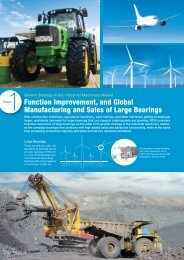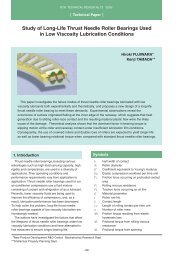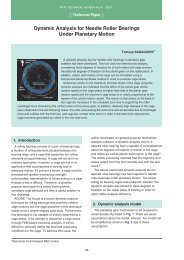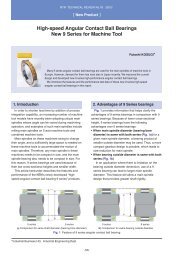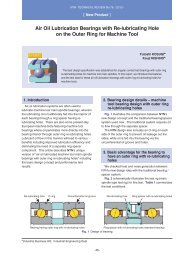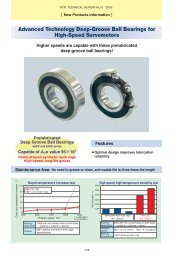Special Issue; Products for Industrial Machinery - NTN
Special Issue; Products for Industrial Machinery - NTN
Special Issue; Products for Industrial Machinery - NTN
Create successful ePaper yourself
Turn your PDF publications into a flip-book with our unique Google optimized e-Paper software.
<strong>NTN</strong> TECHNICAL REVIEW No.742006<br />
Fig. 2 New design<br />
Grease pockets<br />
when a bearing is used at a higher speed range, the<br />
bearing ring of the author’s bearing is made of a<br />
special carburized steel that has an optimized alloy<br />
composition.<br />
In bearing per<strong>for</strong>mance test, the newly developed<br />
bearing was run at a maximum speed of 190 x 10 4<br />
dmn (150 x 10 4 dn), exceeding the target of the<br />
development ef<strong>for</strong>t of 170 x 10 4 dmn (135 x 10 4 dn).<br />
Thus, the author proved that the newly developed<br />
bearing design features limited temperature increase in<br />
comparison with the conventional BNS type (Fig. 3).<br />
Note that, at same dmn values, the temperature<br />
increase in the 100 mm bore diameter bearings differ<br />
from those of the 30 mm bore diameter bearings. This<br />
is because of the difference in the construction of the<br />
test rigs (Fig. 4).<br />
2.3 Grease life (lubrication life)<br />
One important consideration in determining the<br />
lubrication specifications <strong>for</strong> a main spindle bearing is<br />
grease life (lubrication life). The useful life of any<br />
grease greatly varies depending on its operating<br />
environment. The typical factors that greatly affect<br />
grease life include the operating temperature, bearing<br />
load (preload) and ingress of <strong>for</strong>eign matter (chips,<br />
etc.).<br />
Unlike the main spindles used on the test rigs, main<br />
spindles used on real machine tools feature better<br />
sealing per<strong>for</strong>mance in order to avoid ingress of<br />
coolant during machining operation. This means that<br />
heat buildup tends to occur inside machine tool main<br />
spindles.<br />
In addition, main spindles that are more compact<br />
mean smaller bearing-to-bearing distances, which<br />
hinders heat dissipation. Poor heat dissipation causes<br />
Heat increase ˚C<br />
14<br />
12 Dia. 100 New BNS Type<br />
Dia. 100 conventional BNS<br />
10<br />
8<br />
6<br />
4<br />
2<br />
0<br />
0<br />
0 5000 10000 15000<br />
0 10000 20000 30000 40000 50000<br />
Heat increase ˚C<br />
30<br />
Dia. 30 New BNS Type<br />
20<br />
Dia. 30 conventional BNS<br />
15<br />
10<br />
5<br />
Running speed min -1<br />
Fig. 3 Temperature rise test results<br />
Running speed min -1<br />
Dia. 100 test bearing<br />
Dia. 30 test bearing<br />
Fig. 4 Test machine<br />
-30-



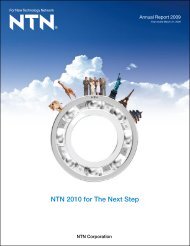
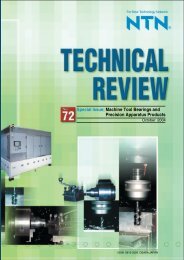
![[New Product] Unit Products for Office Equipment - NTN](https://img.yumpu.com/27154451/1/184x260/new-product-unit-products-for-office-equipment-ntn.jpg?quality=85)
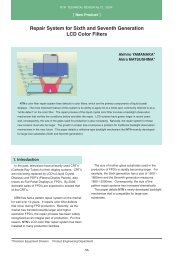
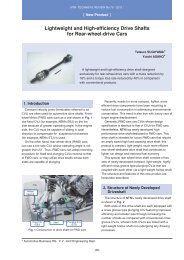
![[New Product] Development of Oil-impregnated Sintered ... - NTN](https://img.yumpu.com/27154427/1/184x260/new-product-development-of-oil-impregnated-sintered-ntn.jpg?quality=85)

